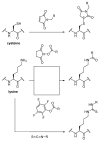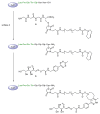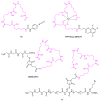Radiolabeling Strategies of Nanobodies for Imaging Applications
- PMID: 34573872
- PMCID: PMC8471529
- DOI: 10.3390/diagnostics11091530
Radiolabeling Strategies of Nanobodies for Imaging Applications
Abstract
Nanobodies are small recombinant antigen-binding fragments derived from camelid heavy-chain only antibodies. Due to their compact structure, pharmacokinetics of nanobodies are favorable compared to full-size antibodies, allowing rapid accumulation to their targets after intravenous administration, while unbound molecules are quickly cleared from the circulation. In consequence, high signal-to-background ratios can be achieved, rendering radiolabeled nanobodies high-potential candidates for imaging applications in oncology, immunology and specific diseases, for instance in the cardiovascular system. In this review, a comprehensive overview of central aspects of nanobody functionalization and radiolabeling strategies is provided.
Keywords: labeling strategies; molecular imaging; nanobodies; positron emission tomography; radiohalogens; radiometals; single photon emission computed tomography.
Conflict of interest statement
R.A.B. is Consultant for Bayer Healthcare (Leverkusen, Germany) and Eisai GmbH (Frankfurt, Germany). R.A.B. has a non-commercial research agreement and is on the speakers list of Mediso Medical Imaging (Budapest, Hungary). M.E. is Consultant for Bayer Healthcare (Leverkusen, Germany) and Eisai GmbH (Frankfurt, Germany), IPSEN and Novartis. All other authors declare no conflict of interest and give their consent for scientific analysis and publication.
Figures
















Similar articles
-
Tumor-specific near-infrared nanobody probe rapidly labels tumors in an orthotopic mouse model of pancreatic cancer.Surgery. 2020 Jul;168(1):85-91. doi: 10.1016/j.surg.2020.02.020. Epub 2020 May 4. Surgery. 2020. PMID: 32370916 Free PMC article.
-
Targeted radionuclide therapy with A 177Lu-labeled anti-HER2 nanobody.Theranostics. 2014 Apr 25;4(7):708-20. doi: 10.7150/thno.8156. eCollection 2014. Theranostics. 2014. PMID: 24883121 Free PMC article.
-
Development and evaluation of nanobody tracers for noninvasive nuclear imaging of the immune-checkpoint TIGIT.Front Immunol. 2023 Sep 20;14:1268900. doi: 10.3389/fimmu.2023.1268900. eCollection 2023. Front Immunol. 2023. PMID: 37799715 Free PMC article.
-
Nanobodies as versatile tools: A focus on targeted tumor therapy, tumor imaging and diagnostics.Hum Antibodies. 2020;28(4):259-272. doi: 10.3233/HAB-200425. Hum Antibodies. 2020. PMID: 32831197 Review.
-
Nanobodies: from structure to applications in non-injectable and bispecific biotherapeutic development.Nanoscale. 2022 May 19;14(19):7110-7122. doi: 10.1039/d2nr00306f. Nanoscale. 2022. PMID: 35535618 Review.
Cited by
-
Development of anti-membrane type 1-matrix metalloproteinase nanobodies as immunoPET probes for triple negative breast cancer imaging.Front Med (Lausanne). 2022 Nov 24;9:1058455. doi: 10.3389/fmed.2022.1058455. eCollection 2022. Front Med (Lausanne). 2022. PMID: 36507540 Free PMC article.
-
PET imaging of HIV-1 envelope protein gp120 using 18F-labeled nanobodies.iScience. 2025 Jan 13;28(2):111795. doi: 10.1016/j.isci.2025.111795. eCollection 2025 Feb 21. iScience. 2025. PMID: 39917021 Free PMC article.
-
Use of pyridazinediones for tuneable and reversible covalent cysteine modification applied to peptides, proteins and hydrogels.Chem Sci. 2023 Nov 1;14(47):13743-13754. doi: 10.1039/d3sc04976k. eCollection 2023 Dec 6. Chem Sci. 2023. PMID: 38075666 Free PMC article.
-
Site-Specific Radiohalogenation of a HER2-Targeted Single-Domain Antibody Fragment Using a Novel Residualizing Prosthetic Agent.J Med Chem. 2022 Nov 24;65(22):15358-15373. doi: 10.1021/acs.jmedchem.2c01331. Epub 2022 Nov 11. J Med Chem. 2022. PMID: 36368007 Free PMC article.
-
Fully automated 18F-fluorination of N-succinimidyl-4-[18F]fluorobenzoate ([18F]SFB) for indirect labelling of nanobodies.Sci Rep. 2022 Nov 4;12(1):18655. doi: 10.1038/s41598-022-23552-8. Sci Rep. 2022. PMID: 36333403 Free PMC article.
References
-
- Debie P., Lafont C., Defrise M., Hansen I., Van Willigen D.M., Van Leeuwen F.W.B., Gijsbers R., D’Huyvetter M., Devoogdt N., Lahoutte T., et al. Size and affinity kinetics of nanobodies influence targeting and penetration of solid tumours. J. Control. Release. 2020;317:34–42. doi: 10.1016/j.jconrel.2019.11.014. - DOI - PubMed
Publication types
LinkOut - more resources
Full Text Sources

